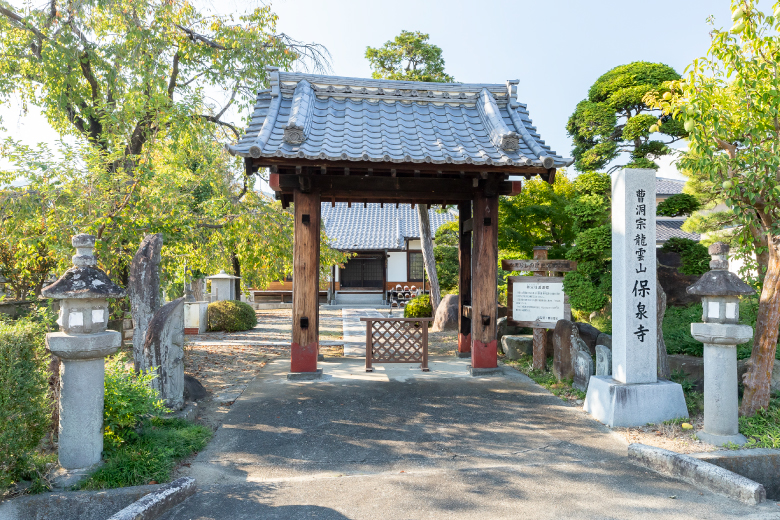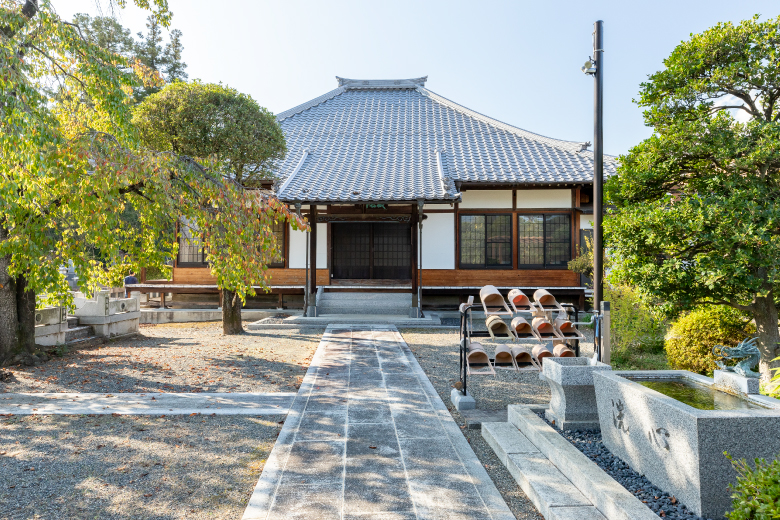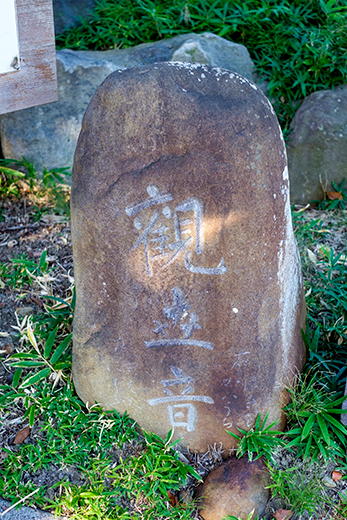Hosen-ji Temple is located in the Betsuden district of Kasugaicho, Fuefuki City.
There was a side road called “Karisakakuchi no Kando” running parallel to the main road of Chichibu Okan Road, in part. Betsuden was located at the junction where Karisakakuchi no Kando branched off from Chichibu Okan Road. Today, this junction corresponds to Betsuden Sansaro, the three-forked road at the Yanagibashi intersection on National Route 140. Some say the name Betsuden comes from this junction, as “betsu” means “to separate.”
From Betsuden, Karisakakuchi no Kando runs through Ochiai, Manriki, Yahata and Kawaura in Yamanashi City and merges with Chichibu Okan Road again in Enzan, Kofu City. Ome Kaido Road, on the other hand, passes through Shotoku-ji Temple and Kamikanogawa in Yamanashi City and Kamiozo and Kamihakihara in Koshu City, and reaches Tokyo via Daibosatsu-toge Pass.
In the precincts of Hosen-ji Temple is a signpost that used to stand at Betsuden Sansaro. It is inscribed with the name “Kanzeon” (Kannon) in the center, the phrase “Hakihara Road to the right” on the right, and the phrase “Yahata Road to the left” on the left. Hakihara Road is another name for Ome Kaido Road, and Yahata Road is another name for Karisakakuchi no Kando. Such signposts indicate that many people had traveled from Koshu to Chichibu via Karisakakuchi no Kando.
There was a side road called “Karisakakuchi no Kando” running parallel to the main road of Chichibu Okan Road, in part. Betsuden was located at the junction where Karisakakuchi no Kando branched off from Chichibu Okan Road. Today, this junction corresponds to Betsuden Sansaro, the three-forked road at the Yanagibashi intersection on National Route 140. Some say the name Betsuden comes from this junction, as “betsu” means “to separate.”
From Betsuden, Karisakakuchi no Kando runs through Ochiai, Manriki, Yahata and Kawaura in Yamanashi City and merges with Chichibu Okan Road again in Enzan, Kofu City. Ome Kaido Road, on the other hand, passes through Shotoku-ji Temple and Kamikanogawa in Yamanashi City and Kamiozo and Kamihakihara in Koshu City, and reaches Tokyo via Daibosatsu-toge Pass.
In the precincts of Hosen-ji Temple is a signpost that used to stand at Betsuden Sansaro. It is inscribed with the name “Kanzeon” (Kannon) in the center, the phrase “Hakihara Road to the right” on the right, and the phrase “Yahata Road to the left” on the left. Hakihara Road is another name for Ome Kaido Road, and Yahata Road is another name for Karisakakuchi no Kando. Such signposts indicate that many people had traveled from Koshu to Chichibu via Karisakakuchi no Kando.
COURSE MAP
Where to next?
Visiting the Enzan-Matsusato area - The water channel that developed the historic road
Tracing culture and lifestyles supported by the water, and the wisdom of making water channels to supply water from the Fuefuki River
Erin-ji Temple Garden is a national-designated site of scenic beauty built by Zen monk Muso Soseki at the age of 56. Muso Soseki is well known for creating the Ryuan-ji Temple Garden and Seiho-ji Temple (Kokedera) Garden. He had significant influence on temple garden designs in the Kai Region. The magnificent artificial mountains and ponds that have remained over 700 years feature the attractions of each season. In Koshu Region, water channels are called segi, and three water channels (Fujiki, Koyashiki, and Ijiri Segi) from the Fuefuki River run in all directions in the Enzan Area to supply water to the river terraces. The water used for the garden at Erin-ji Temple is also from Koyashiki Segi.
The water channels form a network of straight lines in the Enzan Area, and is the basic feature of the landscape of farms on both sides of the water channel. The water not only supported life and business, but also functioned as the foundation of culture seen at temples and shrines, culture such as the gardens.
The water channels form a network of straight lines in the Enzan Area, and is the basic feature of the landscape of farms on both sides of the water channel. The water not only supported life and business, but also functioned as the foundation of culture seen at temples and shrines, culture such as the gardens.
13.0 km / about 7.0 hours / Bicycle


